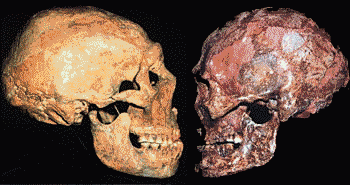More human-Neandertal mixing evidence uncovered
 | 'Dem bones, A reexamination of ancient human bones from Romania reveals more evidence that humans and Neandertals interbred. |
Results were published in the current issue of the Proceedings of the National Academy of Science.
The team found that the fossils were 30,000 years old and principally have the diagnostic skeletal features of modern humans. They also found that the remains had other features known, among potential ancestors, primarily among the preceding Neandertals, providing more evidence there was mixing of humans and Neandertals as modern humans dispersed across Europe about 35,000 years ago. Their analysis of one skeleton's shoulder blade also shows that these humans did not have the full set of anatomical adaptations for throwing projectiles, like spears, during hunting.
The team says that the mixture of human and Neandertal features indicates that there was a complicated reproductive scenario as humans and Neandertals mixed, and that the hypothesis that the Neandertals were simply replaced should be abandoned. ###
Article #08443: "Early Modern Humans from the Pe²tera Muierii, Baia de Fier, Romania" by Andrei Soficaru, Adrian Dobo¨, and Erik Trinkaus.
Subject Matter Experts: Erik Trinkaus, (314) 935-5207, trinkaus@artsci.wustl.edu
Contact: Neil Schoenherr nschoenherr@wustl.edu 314-935-5235 Washington University in St. Louis
Technorati Tags: Neandertals and ancient humans or Romania and Cave of the Old Woman or radiocarbon-dated and fossils or skeletal features and anatomical adaptations or reproductive scenario and Washington University











No comments:
Post a Comment